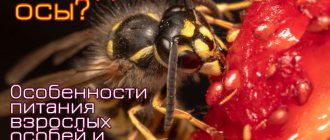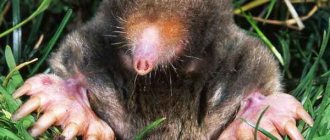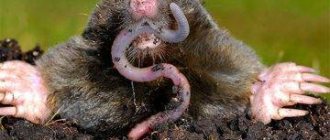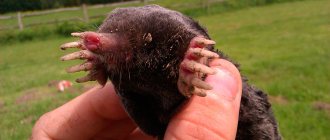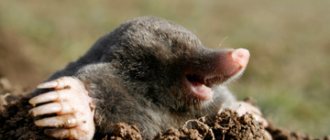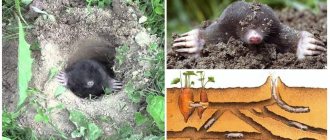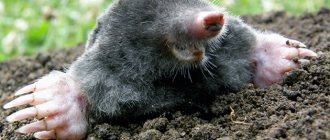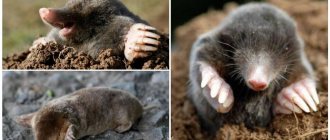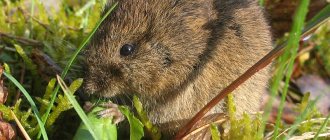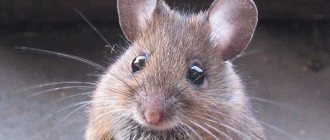Many summer residents and gardeners associate moles only with the appearance of a large number of ugly piles of earth in carefully tended beds, as well as with regular damage to various root crops - carrots, beets, potatoes, onions... And if you ask, for example, a lover of outdoor activities in the country, what If a mole eats, then many would answer that, in fact, it eats these very vegetables - carrots, potatoes, and sometimes it doesn’t disdain garlic.
In general, the food preferences of moles are often attributed to everything that is damaged in one way or another during the life of these animals on the site.
At the same time, even schoolchildren who are little familiar with gardening know well that the mole is a predator, and it feeds mainly on insects and earthworms.
This is a certain contradiction associated with the idea of what exactly moles eat: book and scientific theory says that moles feed on invertebrate animals, but garden practice seems to clearly show that moles eat underground parts of plants.
What is the truth here? Everything falls into place if you understand not only what moles eat, but also how they do it...
Mole's favorite food
Indeed, moles eat mainly invertebrate animals, with earthworms making up the largest part of their diet. This is a fact proven by specially conducted research: scientists caught animals with mole traps, opened the carcasses and then studied the contents of the stomachs.
According to the results of such studies, the following were found in the stomachs of moles:
- Earthworms - more than 90% of the contents; they were found in all captured animals;
- Beetle larvae - about 6% of the contents;
- Other insects, millipedes and crustaceans (woodlice) - about 3%;
- Residues of grains and soft parts of plants, tubers and root vegetables - less than 1%.
We conclude: moles eat mainly earthworms and insect larvae, and also slightly diversify this delicious meat diet with coarser adult insects and various invertebrates, and very rarely eat parts of plants.
In general, these studies only confirm other scientific data. For example, these:
- The structure of the mole's teeth and entire digestive system fully corresponds to the structure of the digestive system of a predatory animal. It has a relatively short intestine, sharp, well-developed fangs and incisors, but rather weak chewing teeth. In addition, the mole's metabolism is very fast, which is typical for animals that eat meat;
- The mole is the closest relative of such predators as the shrew, shrew and muskrat. It would be strange if a representative of a family that includes some of the most voracious predators on Earth turned out to be a vegetarian...
This is interesting
Indeed, the smallest carnivorous mammals on the planet turn out to be the most voracious, if you correlate their body weight with the weight of the food they consume. For example, a shrew, weighing only 5-6 grams, consumes as much food per day as it weighs. If she were the size of a lion, she would need at least 100-150 kg of meat per day. Fortunately, biological laws prevent such voracious creatures from becoming large, and large predators from being such active eaters.
To put it simply, a mole is the same shrew, only it has switched almost completely to an underground lifestyle. But this transition did not affect food preferences in any way - moles eat everything that their common ancestors with shrews ate.
At the same time, the mole eats mainly earthworms not so much because of their unique nutritional value or taste, but because of their abundance and prevalence in the fertile layer of the earth. The animal is constantly moving in its underground tunnel, or digging a new one, and at the same time catches and immediately eats everything that comes in its way. If you come across an earthworm, it will eat it; if you come across a slug or centipede, they will also go for a “snack.”
Of course, a mole’s diet varies somewhat depending on what biotope it lives in and what soils it digs its burrows in. For example:
- In the forest, the mole feeds on earthworms, but approximately a third of its diet in the warm season also consists of large ants, woodlice and centipedes that accidentally crawl into its underground passages;
- In the meadow, moles also mainly eat worms, but here an important part of their diet consists of larvae and adult insects (usually pests of plant roots): beetles and their fat white larvae, wireworms, and butterfly caterpillars. Since there are a lot of plant roots in the meadows, there are more of these pests here than in the forest, and they end up “on the mole’s table” more often;
- On soils with a significant proportion of sand and clay (which, by the way, these animals do not like), moles are limited in nutrition. Here a larva or beetle is a rare delicacy, and as a result, almost the entire diet of the dungeon dweller consists of the ubiquitous earthworms.
On a note
The hunting grounds of moles can be located on the borders of different biotopes - part can be located under a tree grove, another part - in a forest clearing or under a field. The inhabitant of such a site can significantly diversify its diet, moving either under the roots of trees or onto oily, plowed and fertilized cultivated soil.
However, the predatory nature of moles is far from limited to worms, insects and their larvae. Few people know that if a mole has the right opportunity, he does not disdain almost anything that moves and consists of flesh...
What else can be included in the diet of a dungeon dweller?
If a mole in its feeding passage discovers any living creature that is smaller in size and with which it is able to cope, it eats it.
For example:
- The mole eats the mole cricket - this is a large and therefore nutritious insect, which, moreover, is low-hazard and non-toxic, and serves as an excellent snack for the animal. Partly due to this, the mole is not such an unambiguous pest in gardens and summer cottages - sometimes the benefits of its feeding on mole crickets exceed the damage it causes to the beds;
- Moles even eat mice. Of course, they are not purposefully looking for them, but when, digging a new tunnel, a mole “breaks into” a mouse nest with little mice, the fragile animals almost always serve as food for an insatiable predator. Moreover, even adult mice that run into underground passages can be eaten by a mole, although this happens very rarely, since the mice are too agile and manage to escape;
- Lizards, frogs, small toads and snakes also often become victims if they fall into wormholes and meet the “master of the dungeon” in them;
- Moles also eat spiders, even large and poisonous ones, such as tarantulas, but, again, much depends on the ability of the potential victim to quickly escape from the predator. The situation is similar with ants - the mole eats them as it moves, without stopping too much.
On a note
The feeding passages of moles themselves are a kind of traps into which various victims of these animals often fall. Spiders and centipedes crawl into them, earthworms burrow into them, small mammals run in, and lizards hide. One of the important tasks of moles is to regularly check the dug passages, and if suddenly they stop “catching” the required amount of food, dig new “traps”.
In rare cases, moles can eat their own brothers. These animals are very aggressive towards other individuals in their feeding area, and when they meet, conflicts and fights occur between them, sometimes ending in the death of one of the animals. The winner does not show much scrupulousness, and can quite calmly eat the defeated opponent.
It is also useful to read: Do moles have eyes and do these animals need vision underground?
Accordingly, when faced with a shrew smaller than itself, the mole will try to diversify its diet with it.
Thus, in nature, the mole feeds not only on insects or worms, but on almost everything that moves, and with which the generous soil deigns to please it.
Various remains of plant food, which are found in the stomachs of moles during autopsy, enter the animal’s diet only sporadically, often by accident - during continuous digging of underground passages and eating worms and insects among the roots of plants. In general, plant food is not significant for the animal.
What does a mole eat in winter?
First of all, it is worth noting that moles do not hibernate in winter, continuing to dig underground passages and actively feed.
In winter, the mole eats everything that it eats in summer, but adjusted for changes in the proportion of corresponding food objects in the soil. For example, in the summer, beetles and ants are found in large numbers in the ground, but in winter, neither one nor the other can be found (most of the beetles die in the fall, only larvae remain in the ground; and ants practically do not move outside the anthill in winter) .
In the winter season, the mole may come across pupae of beetles and butterflies, shallow-overwintering wasps, hornets and some other insects in the soil - all this also forms part of the animal’s winter diet. However, moles do not change their habits with the onset of cold weather, and continue to consume mainly earthworms. Fortunately, this food does not disappear from the soil (in winter, earthworms burrow deeper and fall into suspended animation).
In addition, in winter, moles also feed on worms, stored since the summer and “stored” in abundance in various parts of the underground passages. The animal bites off the front half of the worm’s body (“head”) and eats it immediately. The back part of the body, unlike the front, is not capable of regeneration, and dies quite quickly, thereby remaining a kind of “canned food in reserve.”
This is interesting
The idea that if you cut an earthworm in half, two viable halves will appear is deeply erroneous. Only the front half is capable of regeneration, and the back half always dies.
Sometimes the mole paralyzes the worm by biting through the nerve ganglion - as a result, the worm does not die immediately, but it cannot crawl away, simply lying in the feeding passage and waiting for the hungry animal to stumble upon it again and feast on completely fresh meat.
In different mole holes, researchers found up to several hundred worms.
On a note
The mole makes its reserves for the winter when there is an excess of worms in the summer, when, when moving along the passages, it constantly encounters them, but due to overeating, it can no longer eat right away. In this case, the mole, practically without stopping, bites through the worm’s body exactly in the right place and continues on its way. And already in winter, checking its passages, the animal comes across such canned food and eats them. The mole can also store worms in special compartments of its burrow system.
In addition, in winter, shrews and mice often find themselves in mole tunnels, for which at this time of year it is much more difficult (and sometimes even impossible) to move under or on the snow. Getting into the tunnel, the animal tries to find here either an insect (if it is a shrew), or roots and tubers (if it is a mouse), and may encounter a mole...
Note that wherever the mole lives, in winter and early spring there is a significant mortality of these animals precisely from lack of food. Due to its very fast metabolism, the insectivorous animal cannot remain hungry for more than a day, and in winter it often does not find anything nutritious within a day.
A little about the mole’s nutritional “culture”: when, how and how much does it eat?
The mole eats a lot and often. During the day, he eats about 5-8 times, crawling out of the nesting chamber in which he rests, and for a very long time collecting food in the feeding passages.
Between meals the animal rests and sometimes sleeps.
On a note
Digestion of a portion of food lasts about 4-5 hours for a mole. After this time, the animal becomes hungry again, and after 16-17 hours, if it does not find food, it weakens and quite quickly dies from hunger. Thus, the mole literally needs to constantly eat.
In one sitting, a mole eats about 15-20 grams of food, and in a day - about 50-60 grams. As a rule, he needs an amount of food per day that is 60-70% of his body weight, although in times of hunger he can “get by” and 20-30%. And on “fat” summer days, while fattening up, the animal can eat as much as it weighs.
It is also useful to read: How does a mole winter and does it hibernate in the cold season?
It may seem that the mole eats a lot (if a person consumed the same amount of food in relation to his weight, he would have to eat 40-50 kilograms of meat per day). Such gluttony of animals looks fantastic, but from a scientific point of view it is quite easily explained:
- Moles have a very fast metabolism. This means that the food consumed is converted into energy or fat reserves in their body within a few hours. After this, the animal needs to eat again;
- Moles are very active and spend a lot of energy. Only those who have not seen them might think that they are clumsy, slow animals. In fact, the mole is very fast, and if it does not sleep, it is constantly in motion, which means it constantly wastes energy that needs to be restored;
- In search of food, the mole does a lot of hard work, so to speak. Figuratively speaking, his energy investments in searching for food are very large, and in order to at least “beat them off”, he needs to eat a lot. To understand this statement, imagine that in order to get a portion of food you need to dig a hole in the ground with a diameter equal to the width of your shoulders and a length of about a meter. Also imagine how much energy you will spend on this and what the portion of food should be in order to at least restore strength after such work;
- Due to the small size of the mole's body, heat transfer in relation to its mass is significantly higher than that of larger animals. This means that, constantly staying in cold ground, an animal needs more food to maintain body temperature than, say, a person or a dog.
When feeding, the mole sometimes simply moves along the passage, picking up its victims in it, and when it is full, it moves into the residential passage and rests there. If necessary, the animal begins to dig new passages.
In winter, the mole requires slightly less food than in summer, due to which it can survive in conditions of a reduced amount of food.
There are no pronounced fluctuations in daily feeding activity in moles. Except that at night the animals more often dig new tunnels and come to the surface, so at night they consume less food. But in general, these animals eat and rest approximately evenly throughout the day.
Main varieties
The classification of moles implies the existence of over 40 species. Among them, the most common are about one and a half dozen subspecies.
East Asian
Animals from the Mole family. They are found in mid-mountain meadows and forests of East and Southeast Asia. Little studied, do not have well described characteristics.
Mogers
Moles with a body length of 9–25 cm and a weight of 290–300 grams. They differ from their relatives of other species in their brownish-brown hair, the specific structure of the auditory apparatus and pelvic bones. There is no fang in the lower jaw. The eyes are covered with leathery membranes and are not visible from the outside.
Ordinary
The animal is known as the European mole. It has a rounded oblong body, an elongated muzzle and a short neck. The limbs are small, adapted for digging. The front legs end in spade-shaped palms that are turned outward. They have powerful claws.
American shrew
The most popular species of mole in North America. Their habitat is wet areas. They have soft and dense fur. The tail is long, equal to half the body. The length of the animal itself is about 10 cm, weight – 10 grams. The eyes are small, the paws are less adapted to digging than those of other subspecies. The animal can swim and climb bushes.
Hairy-tailed
Another American-Canadian species of moles. The animals weigh 50 g and have a body length of 3.5 cm. The head is strongly elongated. The upper incisors are better developed than the other teeth. The animal sometimes crawls out to the surface of the ground at night.
Whitetail
A representative of Moles, distinguished by its white tail. In general, it looks almost like all other moles. Found throughout Bangladesh, India, China and Myanmar.
Eastern American
A large mole, 16 cm long and weighing 75 g. The front legs are wide and powerful, well suited for digging. There is no hair on the paws. Their width is greater than their length, the hind and front toes are fused.
Does a mole eat carrots, potatoes and other root vegetables?
There is a myth that moles love to eat root vegetables in garden plots, for which they are very disliked; gardeners themselves persecute and destroy them. In fact, moles do not eat potatoes, carrots, or, especially, garlic. And the myth itself is due to the following reasons:
- When making a move, the mole, as they say, “breaks through” - carrots, potato tubers, and onions crumble under its powerful claws. Where the animal decides to get to the surface, it breaks the bed and either throws the root of the plant to the surface, or the same root falls into the dug tunnel. Of course, by doing this the mole spoils the plantings, and the inexperienced gardener gets the impression that the animal is simply eating his harvest;
- Molehills are actively used by mice and voles, precisely in order to get to juicy root crops. Gardeners rarely see the animals themselves, but they notice well that along the molehill all the tubers are beaten and gnawed. A person's thoughts are easy to read here;
- In the south of the country, in the zone of steppes and semi-deserts, gardens are damaged by rodents leading an underground lifestyle - mole rats, mole rats, zokors and some of their relatives. They actually feed on roots. Gardeners, not really understanding who dug the underground passages, blame everything on real moles.
At the same time, in vegetable gardens and cultivated lands, moles eat the same thing that they usually like to eat in the forest or meadows - that is, not potatoes or carrots.
How to get rid of it using folk remedies
Moles can leave those parts of the garden where the owners have placed foul-smelling protein food - rotten eggs, fish, chopped onions - into their new, recently appeared holes.
Essential oils of pine and lavender, castor oil, and gum turpentine will help scare them away. Pieces of natural fabric or cotton wool are impregnated with these substances. They lay the material in the passages, above which there is freshly dug earth. The holes must be filled and compacted.
In addition, odorous substances are mixed into dough balls made from flour and water. The balls are dropped throughout the area with a distance of 0.5 m - 1.0 m from each other. Strong-smelling technical materials such as gasoline, tar, kerosene are simply poured into the holes and the holes are sealed.
If there is a mouse-cat in the house, he can easily retrain if he is shown how a mole moves in an underground passage at the moment the soil is thrown to the surface.
Mole feeding in gardens and summer cottages
In vegetable gardens and orchards, while the mole does harm, it also brings benefits, since it eats mole crickets, wireworms, May beetle larvae and slugs. Ants, which gardeners often unsuccessfully try to fight, also suffer from moles - the animals can very effectively restrain the growth of anthills.
And yet, the basis of the diet of moles in summer cottages and vegetable gardens is earthworms. Again, not because animals love them very much, but because in beds generously fertilized with manure and constantly loosened, there are more of these worms than other invertebrates, and they are most often caught by animals when checking their hunting passages.
Considering that earthworms themselves are useful for the garden, by feeding on them, moles cause additional damage. And, as research shows, the harm to an animal exceeds the benefit it brings to a summer cottage or a separate garden.
Effective ways to fight
Since the activity of a mole on the site will allow you to effectively get rid of many harmful insects, it is logical that you need to get rid of the animal itself after it has performed useful work. In this case, it is better to choose control measures that expel, rather than kill, the mole. After all, this may turn out to be a Red Book species.
You can get rid of a mole in the following ways:
- The most effective and simple way to combat it is to plant plants in the garden that have a strong odor. Such plants can be tagetis, celery, hyssop, basil, dill, etc. These plants need to be planted in small groups, but throughout the entire area. 1.5 months after planting, they will begin to emit an odor and the moles themselves will leave your “hospitable” garden;
- You can remove these animals by burying waste from salted herring (spoiled fish, entrails, heads, etc.) at the exit from their burrows. But this method of control is less effective, since after the fish waste has completely decomposed in the ground, the animals will return. Then you will have to get rid of them again.
Another method of control is to transplant daffodils. It's all about the smell again. Moles cannot tolerate it and therefore will very quickly leave your summer cottage. They need to be planted near mole holes. A positive result will be noticeable within a couple of weeks.
A less effective control method is the use of mole traps. This product will help get rid of animals quite quickly. But moles also quickly learn to get around such obstacles. Today there are several types of such traps. They are small tubes with caps on both sides.
Another tool often used in gardens to combat moles is a mole trap or traps. The animal will not be able to get out of such a device on its own. But the question here is different: how to install a mole trap in holes? To install, you need to remove the top layer of earth near the hole. We install the trap in an open form. Remember that installation should only be carried out while wearing gloves. Otherwise, the animal will smell your scent and avoid the trap.
In addition to the methods described above, some gardeners suggest using special “repellents” to protect against moles. Their operating principle is to generate a variety of loud sounds. Such “repellents” can be made with your own hands in the form of rattles, plastic bottles and various noisemakers. But this remedy is actually practically ineffective, although it is popularly known as an “excellent method.”
Folk methods of struggle include:
- use of reeds. Its length must be at least 2 meters. Clean the insides of the reeds and insert a tube into it. Bury the resulting structure in the ground, leaving 60 cm above the ground. With the help of the wind, the reeds will create a sound that scares away animals;
- the most difficult way is to dig hard material (slate, linoleum) into the ground. You need to dig it in to a depth of 70 cm. As a result, you will get a physical barrier against moles;
- flooding holes with water.
Another means to effectively combat moles is the use of various poisons. There are several types of poisons available on the market. Before using such products, be sure to read the instructions for use.
Please note that if you completely destroy the entire mole population within your area, in a couple of years you will suffer from an invasion of mole crickets, chafers and other insects that will not only damage your crops, but infect them with various diseases. So moles, compared to this “happiness”, will seem to you the lesser of evils
Therefore, in a situation where you need to get rid of moles, it is better to choose non-radical methods of control.
Who eats moles?
In turn, moles themselves often become victims of other predators. They are actively hunted by birds of prey (harriers, buzzards, eagles, owls), as well as foxes, wolves and dogs, martens. Young individuals are even eaten by weasels, which actively climb into mole holes in search of owners.
At the same time, some predators eat moles only in times of famine, since the animals smell strongly of musk and do not have a pleasant taste. This is partly why moles are not eaten in any cuisine in the world, even in China, where, it would seem, they can cook kebab from anything.
In nature, animals and birds that feed on moles can catch the animal, kill it, but, feeling the smell and not being hungry, they leave them at the place of capture. The same often happens with shrews, which have an even more unpleasant odor.
Interesting video: a mole catches and eats first a lizard and then a frog
Lifespan
You need to know the enemy by sight.
The mole in nature has many enemies. These are all kinds of predators, such as:
- foxes;
- cats;
- raccoons and raccoon dogs;
- ferrets;
- caresses;
- martens;
- hedgehogs;
- storks;
- owls;
- hawks;
- crows.
Any of the listed creatures, if they do not eat moles, can easily kill the animal on occasion, like dogs or domestic cats. But birds and mustelids, especially the little weasel, are among those who eat animals. The weasel can even chase an underground digger into his own tunnel.
Well, we must not forget about the very tense relationship between man and this animal. It’s also worth saying here that moles always live alone, and the penetration of an uninvited guest into someone else’s territory can also end very badly for him.
In general, this animal lives 4-6 years, if you're lucky. Which happens extremely rarely, as with all wild animals. Most often, the animal can live for 2-3 years, after which, one way or another, it meets its end.
OUR READERS RECOMMEND!
To get rid of rodents, our readers recommend the Pest-Reject repeller
. The operation of the device is based on the technology of electromagnetic pulses and ultrasonic waves! Absolutely safe, environmentally friendly product for humans and pets. Read more here...
